Search the Special Collections and Archives Portal
Search Results

Photograph of Captain Jim, a Washoe Spokesman, early 1900s
Date
1892
Archival Collection
Description
Transcribed from photograph, "Washo - 5. Captain Jim, A Washo spokesman. In 1892, he traveled to Washington, D.C. to plead with the U.S. Government to stop destroying the pine nut trees and the hunting and fishing rights of his people. Inter-Tribal Council of Nevada. Courtesy of Nevada Historical Society."
Image

Photograph of Death Valley Scotty and others, Bonnie Claire (Nev.), 1950
Date
1950
Archival Collection
Description
Walter Edward Perry Scott, also known as the famous "Death Valley Scotty" stands on the left (in the hat) next to other unidentified individuals. Inscription with photo reads: "The road he predicted in 1880 would be made. 1880 to 1951 becoming a reality 'The Scotty Castle' road. Scotty's first public appearance in many years. He's getting public." See Images 0131 0273-0278 for more. Site Name: Scotty's Castle (Death Valley, Calif.)
Image
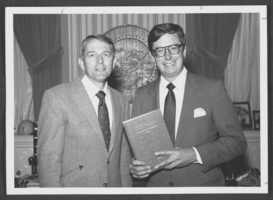
Photograph of Stanley Paher and Robert List, 1981
Date
1981
Archival Collection
Description
Portrait of Stanley Paher (left) and Nevada Governor Robert List (right). List is holding Paher's book, Nevada: An Annotated Bibliography.
Image

Photograph of Captain Pete, early 1900s
Date
1900 to 1920
Archival Collection
Description
Transcribed from photo: "Washo - 1. Captain Pete was one of the early spokesmen for the Washo in their dealings with whites. He was often called upon to defend Lake Tahoe and the pine nut hills. Inter-Tribal Council of Nevada. Courtesy of Nevada Historical Society."
Image
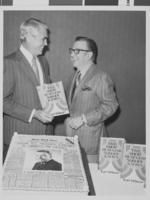
Photograph of Mayor Oran K. Gragson (left) with author Earl Wilson, circa 1971
Date
1969 to 1972
Archival Collection
Description
Las Vegas Mayor Oran K. Gragson (left) with author Earl Wilson. Mayor Gragson is holding a copy of Earl's book, The Show Business Nobody Knows. A large cake decorated as a newspaper announcing the publishing of the book sits on the table in front of them. The location where the photograph was taken is unknown. Oran Kenneth Gragson (February 14, 1911 – October 7, 2002) was an American businessman and politician. He was the longest-serving mayor of Las Vegas, Nevada, from 1959 to 1975. Gragson, a member of the Republican Party, was a small business owner who was elected Mayor on a reform platform against police corruption and for equal opportunity for people of all socio-economic and racial categories. Gragson died in a Las Vegas hospice on October 7, 2002, at the age of 91. The Oran K. Gragson Elementary School located at 555 N. Honolulu Street, Las Vegas, NV 89110 was named in his honor. Earl Wilson (May 3, 1907–January 16, 1987), born Harvey Earl Wilson, was an American journalist, gossip columnist and author, perhaps best known for his nationally syndicated newspaper column, It Happened Last Night. Wilson's column originated from the New York Post and ran from 1942 until 1983. His chronicling of the Broadway theatre scene during the "Golden Age" of show business formed the basis for a book published in 1971, The Show Business Nobody Knows. He signed his columns with the tag line, "That's Earl, brother." His nickname was "Midnight Earl". In later years, the name of his column was changed to Last Night With Earl Wilson. In his final years with the Post, he alternated with the paper's entertainment writer and restaurant critic, Martin Burden, in turning out the column. (Burden, who died in 1993, took over the Last Night column full-time upon Wilson's retirement.) Wilson is also the author of two controversial books, Show Business Laid Bare, and an unauthorized biography of Frank Sinatra, Sinatra – An Unauthorized Biography. The former book is notable for revealing the extramarital affairs of President John F. Kennedy.
Image

Photograph of Virginia Page, Miss Las Vegas, Sands Hotel, June 2, 1957
Date
1957-06-02
Archival Collection
Description
Nineteen year old Virginia Page from Brighton, England, winner of Meet Me In Las Vegas contest. Page, as Miss Las Vegas, won a trip to Las Vegas for a week starting June 2, 1957. Here she can be seen wearing a white bathing suit, a sash, and a crown. From left to right, the people standing in the picture include Bob Ottaway, Charles Goldsmith, Virginia Page (Miss Las Vegas), Glen Cradely (Trans World Airlines), and Yolande Donlan (Chairman of the panel of judges for the contest).
Image
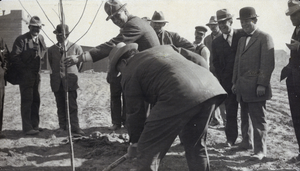
Photograph of several influential Las Vegans planting a tree in the courthouse park, Las Vegas, March 1911
Date
1911-03
Archival Collection
Description
Description given with photograph: "This photo was taken by C. P. Squires on the occasion of planting the first tree in the courthouse park, Las Vegas, Nevada. Date March 1911, as near as can be fixed. The building shown at left is the first Clark County Courthouse (now used for the LV City Library). Las Vegas City Library had been constructed by popular subscription by Las Vegas businessmen as promised by them during the county division campaign in 1908-1909. This building provided sufficient quarters for the county offices for five years, following which, the present courthouse was built. Persons shown, as far as their identity can be remembered are: (holding the tree) Ed W. Clark, (using the shovel) Judge E. L. Taber. Others, left to right: Charles Ronnow; Judge W. R. Thomas; unidentified; Bob Dillon; Frank A. Stevens; Harley A. Harmon and Dr. R. W. Martin (partly in picture)."
Image
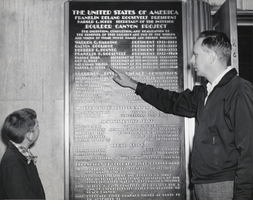
Photograph of Ray Lyman Wilbur II and Ray Lyman Wilbur III, Hoover Dam, circa 1950s
Date
1950 to 1959
Archival Collection
Description
The caption on the back of the image reads, " "Like grandfather, like father, like son" is an appropriate title for this photograph of Ray Lyman Wilbur II and Ray Lyman Wilbur III, reading the name of Ray Lyman Wilbur I on a bronze plaque at the Hoover Dam. As noted on the plaque, Ray Lyman Wilbur I was secretary of the Interior during President Hoover's administration and played a major role in administrative matters pertaining to the construction of Hoover Dam. His son and grandson, shown here, were visitors to the dam recently and were given a specially-conducted tour by the Bureau of Reclamation's guide service. The father and son reside at 1808 Indiana Street, Vallejo, California. The plaque is on the left hand side of the entrance to the Hoover Dam's Arizona elevator tower through which a third of a million visitors leave the dam and power plant each year following guided tours of this mammoth structure on the Colorado River between Nevada and Arizona. Guided tours of the dam and power plant, starting at the elevator tower on the Nevada side, are available daily to the public between the hours of 8 a.m. to 5 p.m. Ca. 1950's (Bureau of Reclamation photo)."
Image
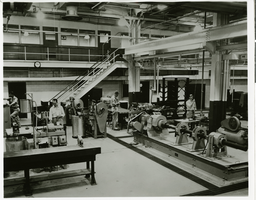
Photograph of the interior of Hughes Tool Co., Houston, Texas, circa 1950s
Date
1950 to 1959
Archival Collection
Description
Transcribed from attached press release: HUGHES TOOL COMPANY Cornerstone of the industrial empire of Howard Hughes is the Hughes Tool Company of Houston, Texas, which last year produced more than half a million rock bits for drilling the kind of deep wells now producing 90 per cent of the world's petroleum. In the company's mechanical testing section (above) engineers test the products under conditions simulating actual drilling. Howard Hughes' father's invention of the rock bit is believed to be one of the most important industrial developments of the century; without such a tool we might still be living in a horse and buggy era."
Image

Photograph of Julian Moore, Las Vegas (Nev.), 1955-1965
Date
1955 to 1965
Archival Collection
Description
Portrait of Julian Moore, taken by Nevada Studios, Las Vegas.
Image
Pagination
Refine my results
Content Type
Creator or Contributor
Subject
Archival Collection
Digital Project
Resource Type
Year
Material Type
Place
Language
